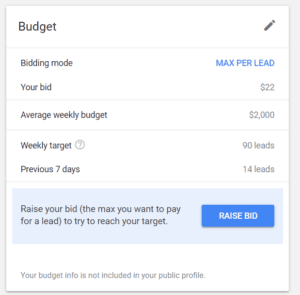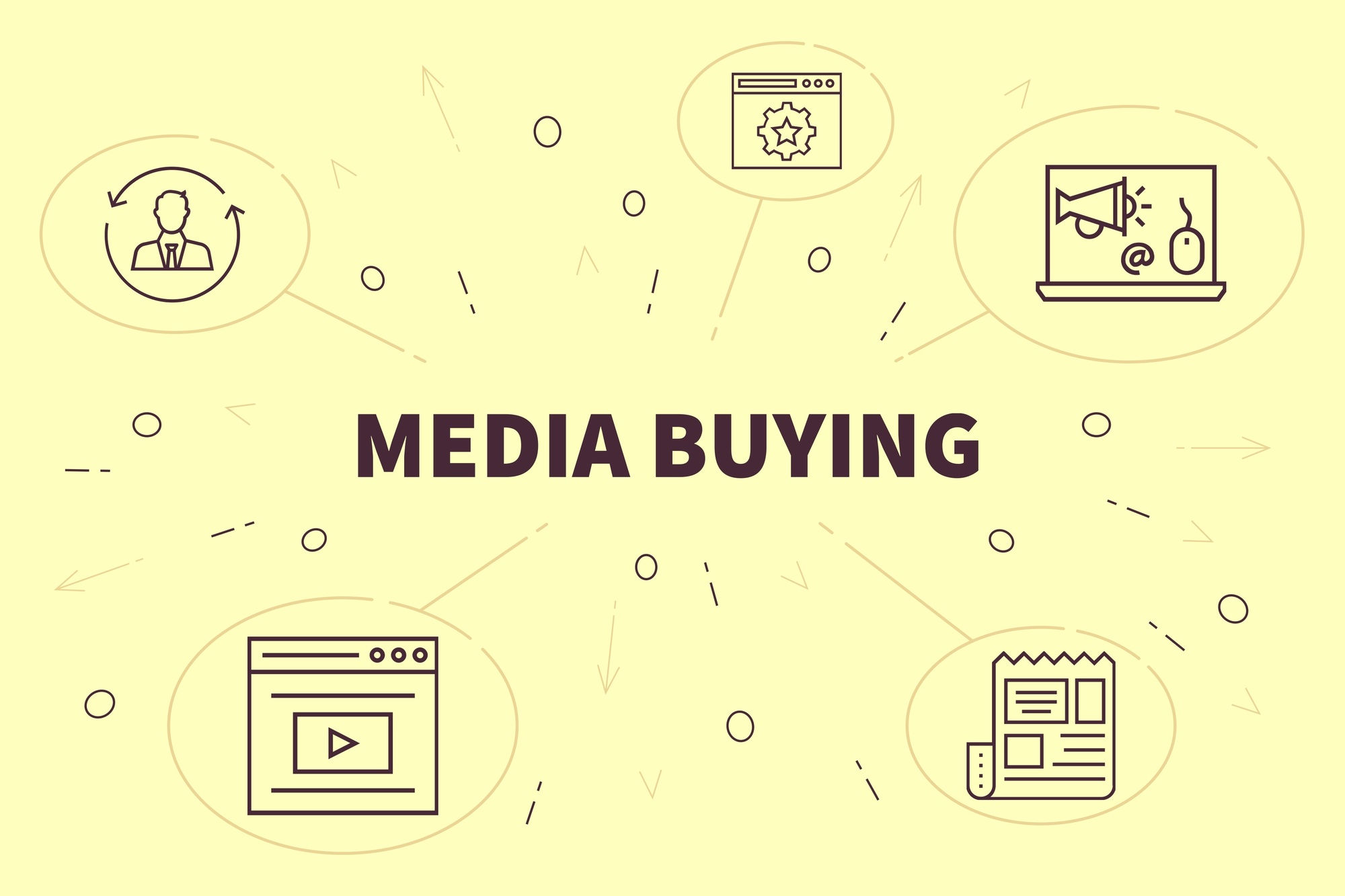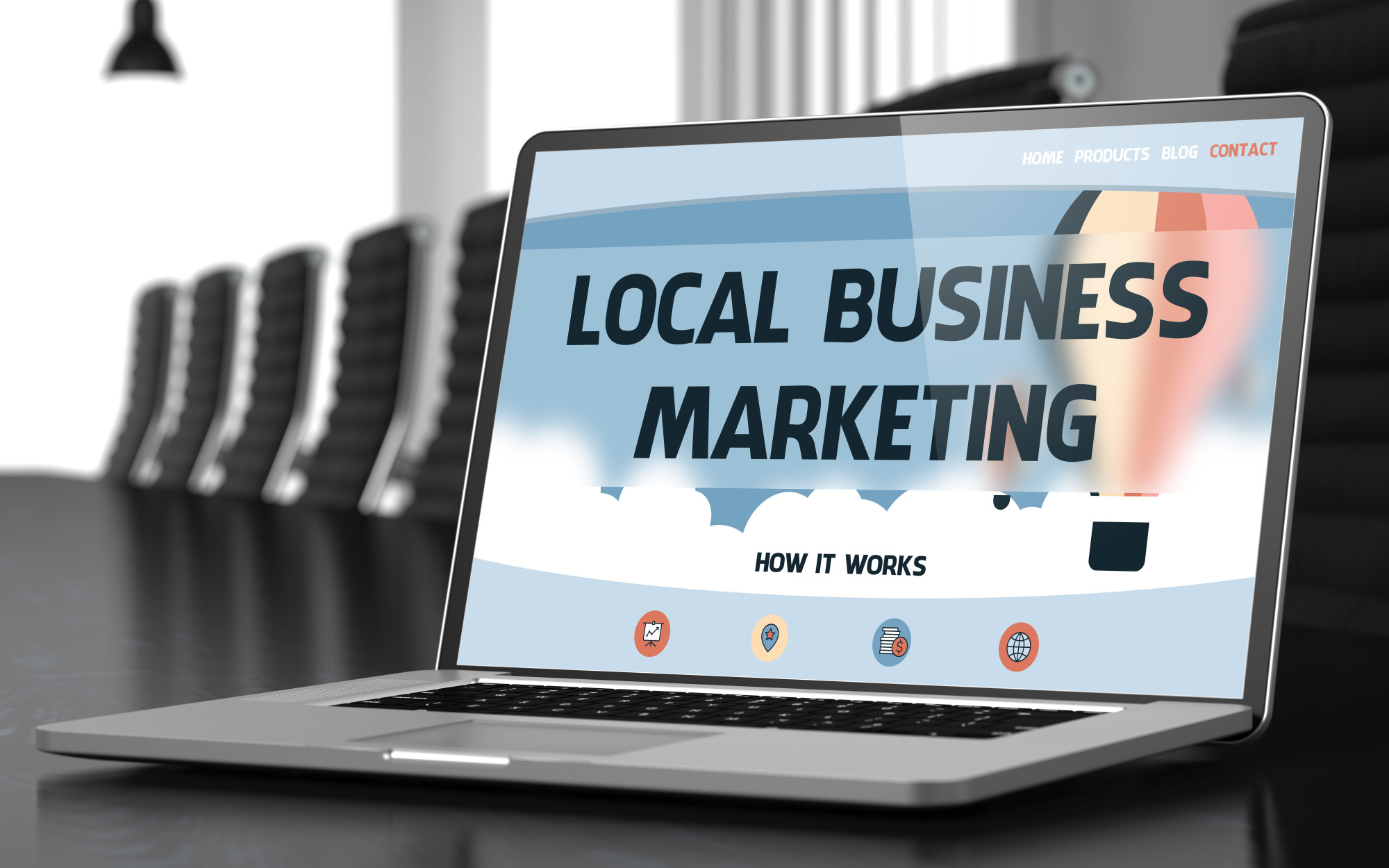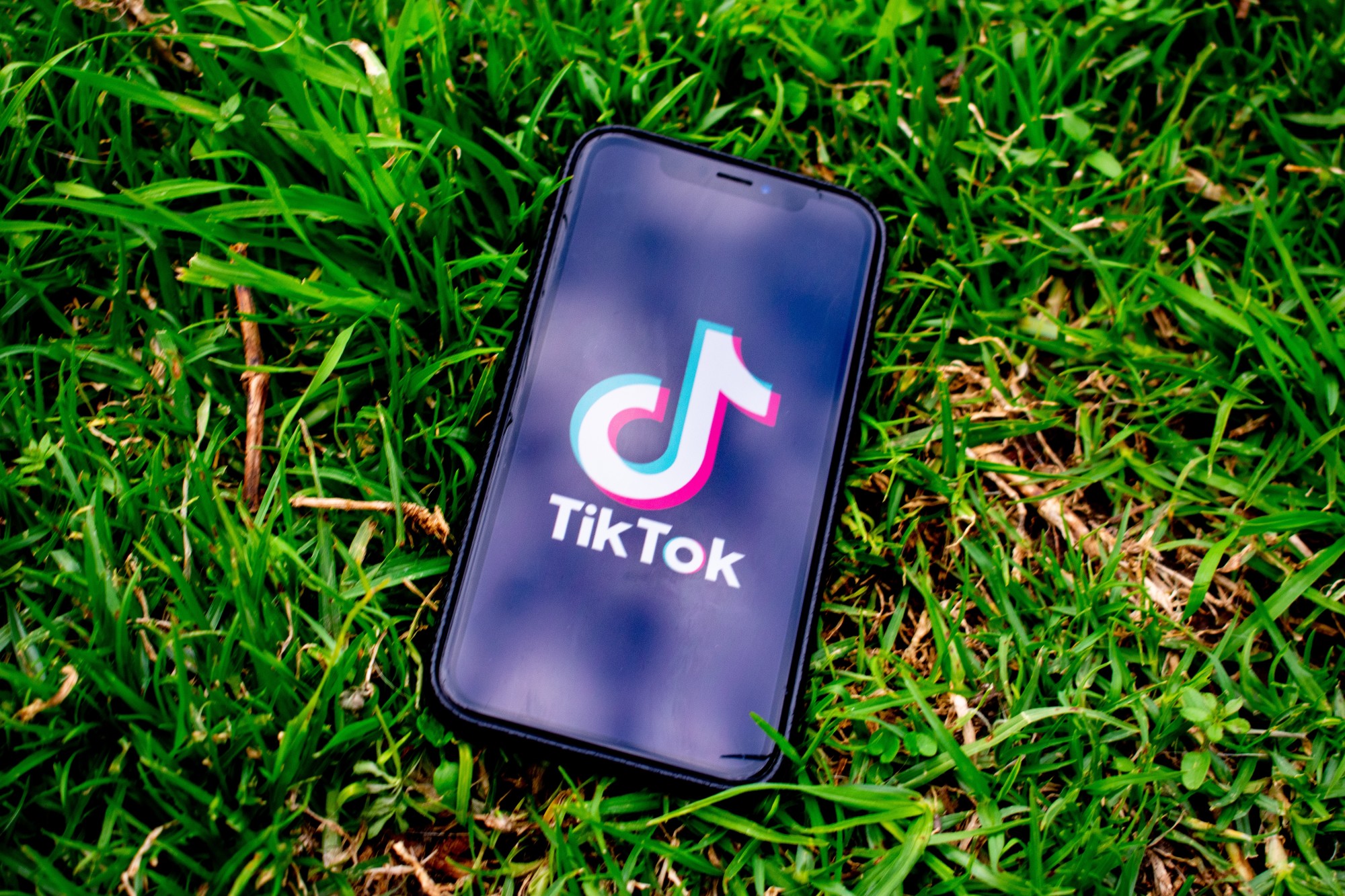Google Local Ads Brings Bidding Features
Google has officially opened up Local Services Ads (LSAs) to auction-based pricing starting October 8th. Select customers were chosen to be a part of this beta test allowing us to test the auction-based bid strategy methodology to pay per-a-lead. This feature is currently only being tested with HVAC and Plumbing companies and will plan on releasing new verticals in the future.
The Meat & Potatoes
Currently, the bidding option available to everyone is made to be simple by setting up a weekly budget and letting their bidding system do the hard work for you (a flat rate of $25/lead). You simply put in a budget you’re willing to pay per week and turn the ad on. Here’s an example:


As of recent, for select beta users, you have the option to select a max dollar amount you want to pay-per-lead and override the “Google Bots” doing it for you. It might look like this in your account:
The selected advertisers don’t have to participate; they can continue using fixed pricing if desired and leave their weekly budget as is if they are unsure how to utilize the new feature.
What’s Next?
According to a Google spokesperson, “After seeing success with auction-based pricing within our professional services vertical for Local Services Ads, we are excited to bring auction-based pricing as a beta to select markets for local services advertisers. We believe this model will help bring more customers to this trusted group of advertisers.”

If you have any questions, reach out to our digital marketing team here at Optic Marketing Group. Our team has a list of all the cities that manual bid features will release in the upcoming weeks, just give us a call at 1-844-700-4781
The 3 Stages of the Media Buying Process
If you're unsure of what media buying is, it's when you buy ad space to promote your message.
It's a way to reach your target market.
In other words, a business that wants media buying should look for the lowest cost that offers the best placement. You want to pay less for people to see it the most.
That's the most basic concept of media buying. However, there's a lot that goes into the strategy behind it. You need to know your target market, the placement of your ads, the conversion rate, brand awareness, and more.
The better your strategy, the more likely your conversion rate will improve and you'll be able to generate sales. If you want a solid strategy, you need to know about the three stages of the media buying process.
This article discusses these three stages and how they can help your business.
Stage 1
Stage 1 is pre-launching.
That means figuring out all the nitty-gritty details before the launch. It's the research behind the launch that will make it successful. Here's all the research you should have compiled before you actually launch.
Know Your Target Market
Understanding who you're targeting is key to any launch. You want to make sure the product or service is the perfect fit for the ideal customer.
When you do have a target market, you need to segment them based on interests, age, demographics, as well as other factors. When you segment your audience, it enables you to send a more specific message. You can send more targeted messages.
Here are some questions you should be asking about your target market:
- What problems do they have?
- Why would they shop at your business or use your services over others?
- What are they thinking about that you could help them solve?
- How do they book your services?
These are just some of the questions to consider when understanding your target market. Ultimately, the more you know about your target market, the more you can help them.
Who Are Your Competitors?
After you figure out your target market, you will need to figure out who your competitors are and why some of the target market chooses to hire them instead of you.
When you're researching your competitors, you need to figure out if they are targeting a different group and how they are advertising differently. Are they offering a service that you don’t offer? What about a rebate or special coupon?
Choose Design and Figure Out Your Budget
Another key part of stage one of the media buying process is the actual design of your ad. You want to choose if your media will be on radio or television. You may decide to also do it on social media.
After you decide, you need to figure out how your message is specifically designed for that media outlet because every one of them requires a unique message.
You also want to set a specific budget to your marketing campaign. You will also have to prepare for unplanned expenses.
If you want to see how we help businesses with the media buying process and our work with past clients, can check it out on our website.
Stage 2
Stage 2 of the media buying process is the actual campaign launch.
This is when your business monitors the campaign and sees if there are adjustments that need to be made. Although you know everything about your target market at this point, you will still need to see how they react to your advertisements.
Worst case scenario, you may need to scrap the entire strategy if the conversion rate is horrible.
But stage 2 is really about how to optimize the campaign. It's important to see how the consumers react and how you can change your campaign to reflect their behavior. That's why it's critical to continue monitoring any changes.
Another important piece here is what happens after customers contact your business after seeing your advertisement. The ads generate the leads, but the internal sales and service teams are what closes the deal. So you will also want to check in on how you are doing during the process as well. If you are finding that leads are not turning into sales, this is where you will want to check for any areas of improvement.
Call listening and call handling are important components of this step, especially in the home services and HVAC industry. In fact, they can make or break your bottom line. You can read our full guide on customer service call handling tips here.
Stage 3
Stage 3 of the media buying process is post-launch.
This is when you figure out what went wrong and right after adjustments were made during the launch. It's a time for discussion and seeing what your conversion rate was.
You should also assess what your ROI was and if it was better than anticipated. You can also evaluate the daily ROI and why it was better on some days during the launch.
After you've done a thorough assessment of your campaign, you can have an idea of what to do better next time. You can figure out if you need to change your audience or change the campaign messaging.
In addition, don't forget to look at the data. It can provide you insight on what part of your segmented list purchased the most. You can also look out for trends.
Overall, it's important to evaluate each stage of the media buying process. You want to ensure that your campaign is set up for success. The more analysis and preparation you put into each state can determine how successful your campaign is.
Now You Know Everything About the Media Buying Process
Now you know everything about the three stages of the media buying process. These 3 stages can help you figure out how to be successful. It's important to take a deep dive into the research and figuring out who you're targeting.
You also want to ensure you choose the right medium to express your campaign to the right audience. You should also take a careful look at the data and see how you can improve your next campaign.
Now it's your turn to succeed with media buying.
The media buying process is quite complex and can be a bit overwhelming, especially when you are just getting started. You can save a lot of time and money by hiring a professional who has this method down to a science. Contact Optic Marketing Group to get started with a mass media campaign for your HVAC or home services business.
A Guide to Billboard Advertising Costs in 2022
Updated October 2022
Are you an HVAC business owner looking to get more local customers for your business? Consider advertising on a giant billboard. Imagine how many people will see your company logo and learn about your business as they pass your billboard.
And if it's lit up at night, people will actually see your ad 24 hours a day. Capture viewers with a short attention-grabbing headline and you're sure to grow your business in a big way.
While driving on the road or walking in your city, one can't help to notice a giant billboard above with your company name on it. By now your interest may be piqued.
And you're wondering what it costs to advertise on one of those big boys? In this post, you'll learn about billboard advertising costs and more about the benefits of advertising on a billboard. Let's get to it.
Billboard Advertising Costs By Region
The price you'll pay for a billboard depends on the region where you live. Here's what you'll pay for a four-week period in five big cities:
- Los Angeles: In 2020 the average cost was $2,000 to 15,000
- Now in 2022 going into 2023
- Bulletins have gone up 25%
- Lesser increases across various different units in the market
- Transit Shelters/Digital Transit Shelters/Jr. Posters have seen a slight reduction in cost
- Cost Revision: $2,250 to $18,750
- Now in 2022 going into 2023
- New York: In 2020 the average cost was $3,000 to $20,000
- Now in 2022 going into 2023
- Bulletins have increased by around 35%
- Transit/Jr Posters/Kiosks/Wall Units have seen a reduction in rate year over year
- Digital Posters on high-arteries have seen a significant increase upward of 43%
- Costs Revisions: $3,500 - $25,100
- Now in 2022 going into 2023
- Philadelphia: In 2020 the average cost was $1,500 to $12,000
- Now in 2022 going into 2023
- Bulletins - saw a minimal cost increase of around 17% with Metro skyrocketing to a 42% upcharge
- Transit Shelter/Junior Posters and Bike Kiosks showed significant decreases
- Cost Revisions: $3,500 - $25,100
- Now in 2022 going into 2023
- San Francisco: In 2020 the average cost was $2,000 to $12,000
- Now in 2022 going into 2023
- Appears to be a very Strong Outdoor market
- Digital/Static Posters and Bulletins have gone up from 36% in 2021 vs 2022
- Junior Posters/Kiosks currently trending up also
- Cost Revisions: $2,5000 - $16,800
- Now in 2022 going into 2023
- Chicago: In 2020 the average cost was $2,000 to $12,000
- Now in 2022 going into 2023
- Digital/Static posters have increased by approximately 30 - 35% in 2021 vs 2022
- Junior Posters, Digital Transit Shelters, and Wall Art have gone down by various percentages
- Cost Revisions: $2,300 - $15,000
- Now in 2022 going into 2023
- Currently, all indications are that the cost per Square Foot has increased to $1.50 vs. $.50 quoted. This would be due to the increase in costs of materials, labor, and lumber. Overall, a minimal rate for digital units and the ability to change quickly and without charge ups to offset the higher monthly rate.
- Bulletin vinyl production and installation rates vary by the market by a run from about $1,010 to $1,800.
As you can see, each city has a wide range, so it's easy to find a solution that suits your budget. Let's take a look at other factors that determine billboard advertising costs.
The Factors: How Much Does It Cost to Advertise on a Billboard?
The price you'll pay for a billboard ad depends on a few factors. One big one is the location. You've heard it before: location. location. location. Let's take a look.
The Visibility of the Billboard
When your billboard is highly visible, the costs reflect that. That's because more people will see your ad. This increases the likelihood of getting more business.
A highly visible spot could be near a traffic light where people in cars stop or on an open highway. You'll pay more for a billboard on the right-hand side because it's easier to see.
Another factor is the volume of traffic in the area. Is the billboard in a busy part of town such as a business district that gets a lot of traffic?
Or in an area that's part residential with fewer vehicles on the road? Both can serve you well because a residential neighborhood could be your customer base.
Cost Per Thousand Impressions (CPM)
Billboard ad costs are determined by something called CPM which means cost per thousand impressions. A billboard along the freeway with 400,000 impressions in a month will cost $2,000.
But when a billboard is located in a spot that gets 30,000 impressions, billboard advertising costs will equal around $600 a month for your ad. These metrics are calculated by travel surveys and studies.
Want to know more about CPM? Ask your advertising company for the CPM data.
Billboard Pricing Is Typically Determined By Four-Week Intervals
Billboard pricing is based on four-week intervals rather than a month. This makes sense since some months have more weeks than other months.
Did a company give you a $1,500 annual quote? This means you're paying for 13 four-week intervals.
Production Costs
Aside from renting the actual billboard, you can also have it produced. Production rates vary depending on the size of the billboard your ad is on and the materials.
Prices range from around $250 to under $800. Here are some production estimates for vinyl which typically run half a dollar per square foot.
- $64: Eight feet by 16 feet billboard
- $189: 10 feet by 36 feet billboard
- $336: 14 feet by 48 feet billboard
Of course, these prices are rough estimates as of 2020. But you'll find they're fairly close or on the mark.
Billboard Location
We talked about pricing in different U.S. cities. But pricing also depends on the area of the city the billboard is located. Let's learn more about pricing using the New York City area and Los Angeles as examples.
New York City
In New York City, a digital billboard in Times Square will remain posted for a two-week period rather than four weeks. The costs to advertise in Times Square range from $10,000 to $22,000.
Want to put a billboard up in Soho? Then it will cost between $18,000 and $30,000 for four weeks. But think of how many people on foot and in their vehicles will see your HVAC company.
However, if you want to advertise your billboard on the highway, you'll pay less for your ad to be posted on a state highway than you would on a freeway. On a freeway, you'll have more eyes on it. More people means more traffic impressions.
Los Angeles
Want to post a billboard in Los Angeles? You'll pay the highest prices in the hub of the famed Sunset Strip since so many people visit the area on foot and in vehicles.
Costs range from $25,000 to $55,000. But if you want your billboard on Sunset Blvd, you'll advertising costs range between $15,000 to $35,000.
Want to target the trendy businesses of Melrose? Your billboard rental will cost around between $9,000 and $15,000. How about Hollywood Boulevard which houses many businesses and apartment buildings? Your costs will range from $7,000 to $13,000.
Put Your Name Up in Lights
As you can probably imagine, pricing is often determined by size. If your billboard is 14 feet by 48 feet, that's 77 percent larger than a billboard that's 10 and a half feet by 36 feet. A larger billboard makes it easier to see your company name.
But imagine if people could see your billboard after dark? A lighted billboard means more impressions and more people reading your company name.
This will bring your company's name to their minds when their AC or heating system fails. Or when they're considering updating their HVAC system. Or when it's time to schedule regular maintenance.
Look Up High: Billboard Advertising Costs Revisited
Now you know more about billboard advertising costs. Advertising your business on a billboard is a great way to get leads for your company and boost sales.
Optic Marketing Group, a full-service HVAC marketing company can help find the perfect billboard location for the best price. Ready to get more eyes on your HVAC business and advertise on a billboard? Contact us today to get started.
This Is the Importance of Advertising During a Recession
One of the first recessions dates back to 1857. One of the key things businesses need to remember with a recession is to never stop advertising. In fact, the cost to advertise your business will drop during a recession.
That's why it's important to advertise during a recession. But there's also another value in advertising during a recession that can help it profit more than ever.
Here's a guide that can offer some insight on the value of advertising during an economic downturn that can actually help your business.
People Are Still Spending Money
Although a recession means there are people with fewer jobs, it doesn't mean they are spending less. They are still spending money, but they are choosing more wisely where to spend it.
That's why it's vital to make sure your business stands out more than ever. It means your advertisements need to be more precise and accurate to your target market.
You want to give people a reason to spend money on your business, especially if they are being more considerate of what they spend their money on. You either need to make your advertisements better or you need to make them more widespread so people see them more.
Your Brand Matters More Than Ever
Another important thing to remember if you are advertising during a recession is that people are looking to spend on brands that they care about. They want to spend money on brands that care about them.
That's why your brand's messaging matters more than ever. Your brand is the story you are telling your audience. It's what the customer feels when they buy your product.
You have to make sure that the customer feels something positive and reassures them they are making a positive purchase.
In addition, you need to make sure your brand stays on the top of everyone's mind. You want to outshine your competitors. You want to show how your brand offers the most to your customers.
When it comes to brand, it's important to convey trust and authenticity. You want people to trust that your brand is better than your competitors. You also want to be authentic and show people that you care about them during a recession.
Most importantly, you want to convey how stable your business is during the recession. You want to show people that they can trust you during a recession and that you're not going to go out of business.
You can convey this trust by writing blog articles or it can show in your advertisements. Overall, you want to reassure people that you will be there for them.
What to Keep In Mind During a Recession
When it comes to advertising during a recession, it's important to remember the key points to any marketing strategy. The goal is to help people through this difficult time from the recession.
As you advertise on social media or anywhere, you want to remember the importance of what people are going through and empathize with them. Empathy can often go a long way.
Here are some things to remember when you advertise during a recession.
Remember Who You Are Targeting.
It's important to remember who you're targeting and what they are going through. You want to create a message that shows you care about their needs.
In addition, you also want to be sensitive to who you are targeting. Your advertisements should be slightly tweaked to reflect the recession. You don't want to assume people will buy from you because they have money.
You want to assume people will buy from you because you care about them.
Choose Your Advertising Wisely
While it's important to advertise during a recession, it doesn't mean you should blow your entire budgeting on every marketing campaign. You want to be precise and think about where people are hanging out.
You should figure out what social media or advertising platform will give you the highest ROI. Or maybe an outdoor billboard would make the most sense as consumers are driving to their destinations rather than flying.
You want to ensure that your marketing campaign is the most effective and not assume that everything will work because it's a recession.
You can see what platforms are the best to advertise on for businesses with this blog post.
Provide More Value
Lastly, it's crucial that you provide more value to your target market.
If your target market needs more help than ever, then you should be willing to give it. That means writing more blog content, offering more guides, and showing people how you can help them.
You want to give as much value to your core market because they will always think about your business and how you helped them. Providing value is a way to constantly remind them that you are there for them.
Why Advertising During a Recession Is More Important Than Ever
Advertising during a recession can offer your business a lot of success. But you have to be sensitive and careful about how you craft our marketing campaign's message.
You want to show people that you care about them rather than enticing them to always buy. If done right, your business can boom during a recession with the right kind of advertising. Yet it's important to understand the correct way to advertise.
Marketing agencies like Optic Marketing Group who specialize in HVAC marketing, know exactly what you need to do to best advertise your services during a recession. If you want help with your marketing campaign, you can contact us here.
Our Definitive Guide to the Google Guarantee Program
Google is the most popular search engine on the web, making it an important ally when it comes to growing your local business. Luckily there are many ways to team up with Google and get your business in front of potential customers or clients.
The Google Guarantee Program is an easy way to earn trust with your potential customers. Learn how to get the Google Guarantee badge for your business and why it is an invaluable tool for growing leads.
What Is the Google Guarantee Program?
The Google Guarantee Program offers your customers a guaranteed refund in the amount paid for the service. This gives your customers an added feeling of security when booking on your site.
They must be visiting your site through Google in order to be backed by the Google Program. Plus, you must qualify for the Google Guarantee badge. To receive a Google Guarantee badge you must be screened by Google Local Services.
Having a Google Guarantee badge is a great way to show your customers that you are a trusted business. They may also be more likely to make a purchase knowing that if they are dissatisfied with work quality, they will be refunded.
What Does the Google Guarantee Program Cover?
The upper limits of lifetime coverage for the Google Guarantee Program's claims are $2,000 US dollars and $2,000, CAD. It will cover claims up to the amount on the job invoice and up to the lifetime cap for coverage.
In order to receive these benefits and be able to make a claim, your customers must book your services through Google Local Services. Any add-ons or future projects, damages to property, dissatisfaction with price or provider responsiveness, or cancellations are not covered by Google Guarantee.
If a customer does file a claim for your services to Google, you are contacted by Google to learn more about the situation. This also gives you a chance to make things right with the customer. Google makes a final decision after investigating the claim.
How Can You Get a Google Guarantee Badge?
Now that you see the benefits of having a Google Guarantee Badge and becoming part of the Google Guarantee program, you're probably wondering how can you get one for your business?
The first step to applying for the Google Guarantee is by signing up for Local Services ads. With Local Services ads, you get to advertise on Google and grow your leads. This is through phone calls and messages sent through your Local Services app. Optic Marketing Group can also help you to get started with Local Service Ads as well as manage them for you.
Why Setup Local Services Ads?
Managing your growing lead database becomes a breeze using the Local Services app. From your phone, you can reply to messages, track bookings, and manage all your leads. Local Services ads help you connect with potential customers by getting your business at the top of Google. You'll be connected to customers searching for the services you provide.
You will only pay for the leads related to your business and the services you provide. Meaning you won't be spending money on people who aren't actually interested. This is because customers are able to choose you. So you'll only be contacted by those who select your profile.
Need Help Getting Started?
Optic Marketing Group is a Google Partner Agency, we can help you set up Local Services ads for your business and walk you through the application process. Working with a Google Partner Agency will help you get your Google Guarantee badge up and running as soon as possible!
Even though Local Services ads and the Google Guarantee program work hand-in-hand, they are two separate entities. So you will still need to qualify for the Google Guarantee badge even after setting up your Local Services ads.
Coming Soon to Google My Business
Although signing up for the Local Service ads is required currently to be part of the Google Guarantee program, this could change soon.
Google is now running a beta program for some Google My Business profiles to be upgraded with a Google Guarantee badge for a monthly subscription fee.
What Is Google My Business?
Google My Business lets you create and verify your local business on Google. This lets your business show up on Google Maps. It also lets you add business information on Google.com.
Using Google My Business helps people in your area find your business when doing a local search. Location extensions allow you to show your business' location in your ads. They also display your name and contact information. Making it easier than ever for customers to find and connect with your local business.
How Can You Upgrade Your Business Profile?
For $50 a month, eligible businesses are being given the option to upgrade their Business Profile with the Google Guaranteed badge. On top of the monthly fee, businesses will still be required to meet Google Guaranteed's regular eligibility rules.
However if your searching for this access for your business, you won't find it. This is still in the early rollout phases and only some Google My Business profiles have been offered the opportunity to upgrade.
Luckily Optic Marketing group will keep you updated on the latest news surrounding this program. So you can take action as soon as it is available. We will always keep our clients up-to-date on the newest products as they roll out.
Get Google Guarantee For Your Local Business
There are numerous benefits to setting up the Google Guarantee Program for your business. With your own Google Guarantee badge, you'll instantly gain trust from your potential customers while also improving your responsiveness.
Want to find out how to get started, earn your badge, and increase your customers? Reach out to Optic Marketing Group, an full-service advertising agency that specializes in HVAC business marketing, to get your business Google Guaranteed today!
How to Turn Negative Reviews Into Positive Business
Is your page getting negative reviews? Do you want to learn how to handle them best?
Most consumers trust online reviews as much as personal recommendations. This behavior also applies to consumers in other age groups to some degree. That means that customer reviews have a big impact on your brand now and especially in the Home Services Industry.
In this guide, we’ll teach you how to handle negative reviews and turn them into something positive. Keep reading to learn how to make the best out of negative reviews on your Google Business page, social media profiles, or website.
1. Use It as a Customer Service Tool
Before anything, you have to look at negative reviews as an advantage to your business. They’re there to help improve your work and services. You can also use them to show that you have a solid customer service presence.
Respond with professionalism and courtesy on the platform, be it on social media or your website. As a business owner, thank them for taking the time to let them know about the issue. Then, move forward to addressing their issue and what they can expect from you.
2. Build a Reputation Management Process
When you put something out there, you have to be ready to receive negative comments about it. That’s the nature of the internet. Expect that someone will always have something negative to say about your work.
That is why you need a plan to know what they’re saying and how to reduce its effect on your reputation. Approach it as you do with customer service calls. Be courteous, build on the positives, and be delicate with the negative comments.
3. Provide Additional Information That Could Be Helpful
A good strategy for using negative reviews positively is to offer helpful information.
Try to offer troubleshooting procedures for reviewers and future readers of that review. For example, a client leaves a scathing review about the ineffectiveness of a product. You can tell them where they may have made a mistake during the setup process or usage of it.
Same goes for a complaint on the service provided, maybe they misunderstood what exactly was included in the service call that they paid for. Clarifying the deliverables can sometimes clear up any confusion that initially led them to believe they didn’t get what they bargained for.
Remember that some people don’t bother reading the product manuals or instructions. Leaving a helpful reply can also save others from having to leave similar reviews when they read it.
4. Implement the Feedback by Improving Your Products and Services
When you hear a lot of people criticize your product in the same way, it may be time to listen. For example, you get a lot of reviews about the same issues with your appointment scheduling process. Try to fix these issues that you hear a lot about from different people.
Lending your clients your ear and doing something about their complaints is a smart move. It doesn’t only improve your product or services. It also shows to your customers that you care about them and that you listen to what they have to say.
5. Build Trust With Your Customers
Trust is vital in gaining a customer base, especially in the home services industry. Customer experience is one of the most powerful builders of trust in customers. A survey found that 98% of business owners say that customer experience is vital in building loyalty.
With every action you take, you have a chance to earn loyalty and build trust. In handling negative reviews, you can build trust by listening and reacting a certain way. Customers will trust a business that focuses on customer experience and shows it.
6. Resolve Issues Before They Escalate
An apology and a promise won’t be enough to please your customers. You also have to recognize the issue and create a solution for it. Otherwise, you risk losing the trust that you worked hard to build.
Rather than sweeping a problem under the rug, attack it head-on and try to solve it as soon as you can. Your customers will know if you listened to their problems and did something about it. When they do, their trust in your company will magnify.
7. Acquire New and Positive Reviews With Paid Ads
Another way to increase the ratio of positive reviews to negative is to gain more reviews. Starting a paid ad campaign helps you out a lot here. Don’t forget to advertise the changes you made to combat negative impressions.
Paid advertising is more effective since it gives you more control over your messages. You get to choose who sees it and when. Because you get a more targeted audience, you’ll get faster results as well as success.
If setting up a paid advertising campaign sounds overwhelming, you can always partner up with a marketing agency like Optic Marketing Group who specializes in full-service marketing campaigns for HVAC businesses looking to generate more reviews.
8. Rebuild the Customer Relationship
Some customers may feel that your connection got cut when they leave a negative review. This doesn’t have to be true from your perspective. You have to show them the same perspective as well, that your relationship isn’t broken.
It may be a little strained, especially after they lost trust in your brand’s quality, but not broken.
To repair it, you can offer to fix the error for free or offer discounts on the next purchases. Be transparent and give customers the information they need to make informed decisions. You can also ask for feedback to show them that you are willing to listen to other things they may say.
9. Ask for a Review Change After Fixing the Issue
This is a bold step, and often one you’d take if you’re confident in your customer service. Don’t be afraid to ask that a customer edit their reviews on your website or Google Business page after you fix an issue. If they liked how you handled and helped solve their problems, many will oblige.
Others may even mention how accommodating and patient you’ve been with them. When other clients see reviews with edits like this, your brand will look more attractive. They’ll take it as a sign that you had handled the situation well.
10. Attract New Prospects
The last thing you can do in learning how to respond to negative reviews is to look for new prospects. You can do this by investing more in your advertising game. Try to attract prospective clients who may leave positive reviews instead.
Transform Negative Reviews Into Something Positive
Those are the ten things you can do to make good business from negative reviews. We hope you realize how impactful a negative review-turned-positive has on a brand. We also hope you learned something useful from this guide.
As a business owner, you know just how important having positive reviews are and how detrimental negative reviews can be. That is why reputation management is one of the most common services that we provide to our clients included in their full-service marketing strategy.
At Optic Marketing Group, we specialize in HVAC marketing, so we know how much reviews impact local, service-based businesses. If you need help on how to get more reviews for your business or on how to handle negative reviews, don’t hesitate to reach out to us.
Should Your Home Services Business Be on TikTok?
TikTok may be an untapped marketing goldmine. The app has over 500 million active users, yet only 4% of social media marketing firms have begun to take advantage of this massive, built-in audience.
Part of this is due to the presence of older, more recognizable social media giants. After all, we've been using Facebook as a marketing tool for over a decade. More recently, Instagram and Twitter also joined the ranks.
It is no secret that TikTok has become one of the hottest social media platforms lately, but that doesn't mean that it makes sense for every type of business to jump on the bandwagon, especially businesses in the home services industry.
The question we keep getting asked: is TikTok good for business? What about for a home services business? What are the advantages and disadvantages of creating a TikTok advertising strategy?
If you have ever wondered if your HVAC business should be posting on TikTok, read on.
For Starters - How Does TikTok Work?
Traditionally, TikTok videos are 15 seconds long. However, in recent months, the app has added a feature that allows users to string together multiple clips to create a 60-second video. In addition, you can upload long-form videos that were recorded outside of the app, itself.
We've discussed the best video marketing practices in the past, and TikTok has great short-form video marketing potential. That being said, there are a few things users expect from TikTok videos. Even if you're using the app for marketing purposes, there are three cardinal rules you should always follow.
1. Use Music
Music has been built into the app's use since the beginning. In fact, the original purpose of the app was to create fun or humorous music videos to popular songs. While it has come a long way since then, you still need to incorporate music--preferably something popular--into your videos.
2. Go For Humor and Candidness
While some use TikTok to create educational content, businesses should stick to lighter, more humorous videos. The idea is to jump straight to the point since you are limited on time. You also want to make sure that you are showing the fun side of your brand in the process.
3. Don't Use TikTok for Your Hard Sell
Anything that feels like an overt ad is not going to perform well on TikTok. As of right now, the app is designed for entertainment purposes. Incorporate your product or service into your video but try to avoid the obvious call to action we're used to in traditional marketing.
Advantages and Disadvantages of Using TikTok for Business
You've now got a sense of how TikTok works. Like Instagram, your content should be image-focused, as captions are considered secondary. Other users can interact with your content through things like following, liking, and ranking, not unlike most other social media platforms we're used to.
It's important to look beyond TikTok's similarities to existing, familiar platforms. What are the pros and cons of TikTok for business purposes? Let's take a look.
Advantage: TikTok Videos Are Easy to Make and Easy to Share
The app is considered extremely user-friendly. You can create videos either on your device or through the app's filming and editing tools. Plus, TikToks transfer well to other social media websites, which means you can cross-market your TikToks and other users can easily share your work.
Disadvantage: Minimal Linking Opportunities
Unlike Twitter and Facebook, TikTok does not allow you to place links in your individual posts. In other words, users won't have the quick satisfaction of clicking through to your website from the post they're looking at.
However, you can place a link in your bio. Websites like Linktree create the opportunity to link to multiple service pages or product pages from a single parent link.
The Youth Factor
Who, exactly, is using TikTok right now? A recent report found that while only 4% of the total US population is using TikTok, a whopping 47% of US teenagers have downloaded the app. The primary age range of users on TikTok is between 16-24 years old.
So if your target demographic includes teens, sure the platform could be extremely valuable to sell your products, but if you are in the home services or HVAC industry, you know that this demographic falls below the demographic of homeowners and people who are making home service based decisions.
Is TikTok Good for Business or Do the Social Media Giants Win?
Where does TikTok rank amongst the social media giants? Which platforms are best for business?
The truth is that Facebook is still the top contender, with more adult users than platforms like Instagram, Twitter, and, yes, TikTok. Plus, people spend more time on average scrolling through their Facebook feed than any other platform.
So if you are looking for the best social media platforms to market your heating, cooling or plumbing business, you can breathe easy knowing you don't need to make the jump to yet another platform. Instead, stick to Facebook as it remains the #1 social media platform for home services business.
On top of Facebook's winning statistics, Facebook's format makes it arguably the best for any business. Facebook allows you to switch between a video, photo, graphic, and text block seamlessly. If you want, you can combine all of these formats in a single post.
Plus, Facebook has a more interactive interface. Customers and clients can do more than follow your page. They can leave reviews that inform future customers' purchasing decisions.
As you know in the HVAC world, online reviews are extremely important and Facebook is the first place consumers are going to leave and read reviews.
Does that mean that you should ignore all other social media platforms? Absolutely not! In fact, Facebook allows you to share just about any other social media post on your Facebook page, maximizing the views and success rate of all of your social media marketing campaigns.
How to Boost Your Social Media Presence
Sometimes, trying to answer questions like, "Is TikTok good for business?" is difficult. The answer depends on everything from your product or service to the amount of time and resources you can devote to social media.
But when it comes to companies in the home services industry, the answer is easy. Instead of worrying about how you can become the next biggest TikTok influencer, focused your efforts on growing your reviews and recommendations on Facebook where you will see the biggest benefit to your business.
As a full-service marketing agency specializing in the home services industry, Optic Marketing Group can take a look at your business and your current digital marketing plan, overall. We can put together a custom social media strategy that makes the most sense for your business.
Interested in how our business can help your business? Contact us today to find out more.
A Business Owner's Guide to ADA Compliance
At least 54% of online users live with a disability. Not every single users' disability relates to web compliance. You still need ADA compliance for your business website.
But what does an ADA compliant website look like? And how can you ensure you meet every standard for your website?
Read the guide below to learn all about implementing accessibility compliance into your website.
A Guide to ADA Website Compliance
Web accessibility is one of the more modern accommodations established by the ADA. The ADA itself only formed in 1990. Making sure policies are updated to accommodate disabilities in every type of user experience is difficult. This makes it a challenge to uphold ADA requirements for websites.
What Is ADA Compliance?
As of 2018, the Department of Justice mandated ADA compliance for accommodation on public websites. Historically, accommodations only applied to physical public locations.
ADA compliance for websites mostly comes from the DOJ's interpretation of Title III. It requires that "the goods, services, privileges, or activities provided by places of public accommodation be equally accessible to people with disabilities." Specifically, it protects from discrimination relative to:
- Public accommodations
- Commercial facilities
- Transportation
- State and local government
- Telecommunications
- Employment
The use of online space is progressively increasing. This makes it important to include persons of all abilities for more than legal reasons.
This process is not something you want to rush. It is an involved process you should invest time and resources into as a caring business owner.
Why Do I Care as a Business Owner?
As a business owner, there are several benefits to including accessibility compliance in your website's design. Unfortunately, many sites are noncompliant. Beyond ease of use for the disabled community, ADA compliance benefits all end-users.
- You'll get exposure to new demographics, which means more clients!
- Your SEO strategy will be optimized on an ADA compliant website.
- You significantly decrease your risk of a lawsuit from noncompliance.
- Corporate diversity naturally increases in unexpected ways.
These benefits are not even the main reason to implement web accessibility on your website. They are certainly good incentives. Your primary reason for compliance should be about doing the moral and ethical thing for your clients.
What Is the Difference Between ADA vs. 508 Compliance vs. WCAG?
ADA compliance is based on civil rights law that prohibits discrimination. This includes public spaces of online interaction. 508 compliance is a federal law for the use of information and communications technology by governmental bodies to include persons with disabilities. WCAG is a set of guidelines set by the ISO.
ADA Compliance
ADA compliance requires general terms of accessibility. Its policies directly affect state and local governments, nonprofit agencies, and businesses. Some critical items to address:
- Your website needs to have complete keyboard functionality.
- Any form fields need coded labels that a screen reader will voice aloud.
- Your alt text for anchors and external links has to be descriptive.
- Content headings should be adequately nested. This prevents interrupting user experience (e.g., taking users to the wrong landing page or section.)
The terms of ADA compliance have set financial consequences for the private and public sectors. Fines increase for repeat offenses, and federally funded projects can even be revoked. WCAG guidelines can help you build an ADA compliant website, as well as a plugin or web design service.
508 Compliance
508 compliance is a section of the Rehabilitation Act. It focuses on the use of information and communications technology between federal agencies and departments.
It applies to these federal bodies. It also applies to people who use resources provided by federal entities (e.g., citizens or employees). Examples of such technologies include:
- Call centers (e.g., telephones)
- Websites
- Software
Its consequences entail formal complaints or civil lawsuits. Following 508 compliance can be done by turning to WCAG for guidelines. You can also consult a web design agency that specializes in this form of accessibility compliance.
Web Content Accessibility Guidelines (WCAG)
Focusing on web accessibility for any device, WCAG works as a guideline for web developers to concentrate on accessible content. WCAG is a reference point for ADA compliance and 508 compliance. It uses four principles to set accessibility compliance standards.
- Perception: alt-text, captions, multiformat content with assistive tech, visual and audible content
- Operation: keyboard functionality, navigation aid, reasonable caption timing
- Understanding: legible text, predictable content, mistake correction and aid
- Robust: compatibility with current and future tools
These principles are measured with success criteria on three levels, A, AA, and AAA. The success criteria determine how accessible a website is under WCAG.
Why Do I Need to Hire a Web Design Agency for ADA Compliance?
You might be asking why you need to hire a web design agency for accessibility compliance for when you can just reference WCAG. Although an excellent reference for general accessibility compliance, with so many regulations, it's easy to overlook a single detail. It is also an overwhelming, technical process that requires a certain level of expertise.
It's also quite challenging to alter the coding settings, which impact your compliance. For example, see this video in adjusting the contrast on one single header. There are several website features to include in for an ADA compliant website.
Where to Turn for Accessibility Testing Design
Now that you know the ins and outs of ADA compliance, it's time to consider your options. There are several web design agencies for you to find. You need a full service marketing agency experienced in accessible web design services.
Optic Marketing Group can audit your current site or build you an entirely new website to support ADA compliance guidelines. After we have completed a site audit for accessibility, we'll walk you through the necessary steps. Contact us today so we can discuss optimizing your business to the best possible standards for accessible user experience.
Customer Service - Call Handling Tips
Customer Service - Call Handling Tips
“Before anything else, preparation is the key to success.” Alexander Graham Bell
Do you want to know how to handle and run client calls efficiently and effectively? Here are 5 tips and best practices our Client Service Team follows in order to exceed client expectations and customer service.
-
Schedule the Call.
Connect and schedule the meeting ahead of time. Ensure the meeting invite is accepted and the proper people are on the call. Scheduling a call with the wrong business contact or scheduling a different date that the client agreed upon can cause havoc and be a huge waste of time. At Optic Marketing Group, we love to schedule client meetings at least once a month to see how business is going, what is happening internally in the client’s business, and talk about what’s happening in their industry.
-
Be Prepared.
Prepare, prepare, and prepare!! Take the time to create your agenda, outline the items you want to discuss on the call. Review reporting, internal questions your team may need you to verify ahead of time will make you be a lot more comfortable and calm on your call. We practice and preach being 100% being transparent with our clients, if you have any negative feedback or results, you’re able to collect your thoughts ahead of time to deliver the information efficiently, concisely and with a solution. Review the client’s contract, ensure you have a clear understanding of what the client’s goals are and what your team has done to get closer to that goal.
-
Read the “Room”.
If you are able to have an in-person meeting with your client, read everyone’s body language. Body language speaks volumes and will enable you to anticipate any uncomfortable nuances that your client may not express. If you cannot have an in-person meeting and are just doing an online meeting, pick up on the tone and hesitations in answers. Understanding the small “silences” allows you to be able to maneuver the conversation to ensure everyone is comfortable with the conversation and the solutions presented.
-
If You Don’t Know, Do Not Fake It.
You don’t know what you don’t know, be okay with saying, “I need to check with the team on that for you, I am not sure.” You would rather confirm the answer with your team rather than putting your foot in your mouth and giving empty promises!
-
Use Your Time Wisely.
Your client does not have all day to speak to you, so make sure you’re asking the proper questions. Prioritize the items you need to review and be flexible to adapt in case your client comes in with a left-field question or concern.
Regularly scheduled conversations with your clients provide much-needed updates on both sides. As a full-service marketing agency, we want to ensure our campaigns are aligned with the client’s goals and objectives. We understand that sometimes those client goals and objectives shift, so we adapt and have that open dialogue.
How To Make Social Post Convert Into Revenue
It's a growing concern that so many people live around water but cannot find water to drink, what I mean is that so many people spend a lot of time growing their followers, fans, and friends on the social media without having a clue on how to convert this vast client base into money generating customers. I don't know if it's that they spend a lot of time posting, retweeting, following, commenting, and pinning that they barely have any time left over to make money.
Don’t get me wrong, I love social media a lot, but then apart from generating a lot of followers, you should know how to channel your followers into your sales funnel. Here are some ways Optic Marketing Group has tested and trusted to convert your Social Posts into Money.
Create a strategy: Strategize the posts you put on Facebook and Tweeter so that they can help you achieve your purpose of posting. Whether you are trying to attract more customers, boost brand recognition, or improving customer service. Whatever the goal, Optic Marketing Group can help you to define your content strategy so that they can portray your key messages and showcase the kind of content that will appeal to your audience, we will also generate a list of keywords that describe your business which will help you rank higher when searched.
Don’t fall for fads: Do you remember Vine? It was popular for some time and vanished after, what about Periscope, this was my favorite because to me, it had the best ROI among other social media networks buy you see, Facebook has stayed, and Snapchat is currently struggling to retain its relevance. The lesson here is that you are free to join any new trend but be smart enough to benefit from when it has benefits and withdraw once it has little to offer.
Drive your social media following back to your website: Some bloggers don’t have a website while some others have abandoned their website and concentrated on social media. Well let me tell you, you need to have an email list, most of our sales come as a direct result of emailing my list about a promotion, not because I posted something on social media. Because a particular social media can be irrelevant at any time, it is vital that you direct your social media following back to your own website where they can really devour some content and opt-in to your email list. We can help you do that.
Have several kinds of free opt-ins to share: Opt-ins are freebies that people receive as a result of subscribing to your email list. It is usually based on what you can offer your audience. So if for example, you are a makeup artist and someone asks you for tips what color will match her skin, simply send the person a link to a free tutorial on your website which they will sign up to and BOOM, the person has been added to your email list, and an automated sales funnel.
Use social media to build trust: Do live videos, answer questions, demonstrate the use of your product and attend to unsatisfied followers, if you can build up trust on social media, you will make more sales on your website.
Why Choose Optic?
Being able to turn your social media followers and friends into business revenue is just one piece of the overall puzzle. It’s also a tricky game, here at Optic Marketing Group, we have learned the tricks and mastered the rules to using Social Marketing Strategies to convert Social Posts into Money.









